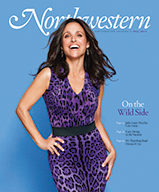
Creepy Oddities Shed Light on Death Traditions
Tell us what you think. E-mail comments or questions to the editors at letters@northwestern.edu.
Ever wonder about those strange designations we use throughout Northwestern to identify alumni of the various schools of the University? See the complete list.
Find Us on Social Media
Librarian Benn Joseph pulls a small sheet of cream-colored cloth from a dark wooden box and unwraps a thick lock of brunette hair, preserved for nearly 150 years. Beside it is a child-sized coffin, a handful of grave markers and embalmers chalk.
These are a few of the artifacts in the 76-box Death Collection at the Charles Deering McCormick Library of Special Collections. Horror author and screenwriter Michael McEachern McDowell, whose screenwriting credits included the films Beetlejuice and Tales from the Darkside, amassed the collection over three decades. It includes photographs, jewelry, newspaper clippings, human hair and other postmortem relics, as well as headstone design samples, funeral gown advertisements and coffin plates. McDowell died in 1999, and the University purchased the collection from his partner, Laurence Senelick ’64, two years ago.
“[The collection] gives you a sense of how people treated this aspect of our lives that we largely ignore nowadays,” says Joseph, a manuscript librarian. It includes several boxes of material on psychics and spiritualism, including “spirit photographs.” These manipulated images, often captured with double or triple exposures, depict the living talking with shadowy, ghostlike figures. Other portraits show families dressed in their best with a recently deceased infant, a final gesture of remembrance that was commonplace during the late 19th and early 20th centuries.
The collection also includes tintypes and daguerreotypes of postmortem adults and children. And shelved away in the corner of the room is a box labeled “atrocities,” which contains gruesome photos of war, crime scenes, murders and freak accidents.
Colorfully illustrated sheet music for many death-themed songs, such as “The Grave of My Mother” and “She Died on Her Wedding Day,” are also part of the collection.
Besides the awe and fascination that attracts visitors to the collection, Joseph says research is a primary draw. A freshman seminar, “Good Grief: Literature of Death and Mourning,” incorporated the collection into its syllabus.
“There’s so much cultural evidence in the collection’s objects and ephemera,” says Special Collections curator Scott Krafft. “Death is a fact, and people want to understand how, over the centuries, cultures and generations dealt with it.”



 Facebook
Facebook Twitter
Twitter Email
Email


